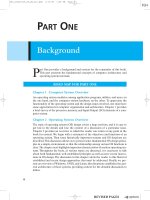Operating system internal and design principles by williams stallings chapter 015
Bạn đang xem bản rút gọn của tài liệu. Xem và tải ngay bản đầy đủ của tài liệu tại đây (516.88 KB, 56 trang )
Distributed Process Management
Chapter 14
1
Process Migration
• Transfer of sufficient amount of the state
of a process from one computer to
another
• The process executes on the target
machine
2
Motivation
• Load sharing
– Move processes from heavily loaded to
lightly load systems
• Communications performance
– Processes that interact intensively can be
moved to the same node to reduce
communications cost
– May be better to move process to where the
data reside when the data is large
3
Motivation
• Availability
– Long-running process may need to move
because the machine it is running on will be
down
• Utilizing special capabilities
– Process can take advantage of unique
hardware or software capabilities
4
Initiation of Migration
• Operating system
– When goal is load balancing
• Process
– When goal is to reach a particular resource
5
What is Migrated?
• Must destroy the process on the source
system and create it on the target system
• Process image and process control block
and any links must be moved
6
Example of Process Migration
7
Example of Process Migration
8
What is Migrated?
• Eager (all):Transfer entire address space
– No trace of process is left behind
– If address space is large and if the process
does not need most of it, then this approach
my be unnecessarily expensive
9
What is Migrated?
• Precopy: Process continues to execute on
the source node while the address space
is copied
– Pages modified on the source during
precopy operation have to be copied a
second time
– Reduces the time that a process is frozen
and cannot execute during migration
10
What is Migrated?
• Eager (dirty): Transfer only that portion
of the address space that is in main
memory and have been modified
– Any additional blocks of the virtual address
space are transferred on demand
– The source machine is involved throughout
the life of the process
11
What is Migrated?
• Copy-on-reference: Pages are only
brought over when referenced
– Has lowest initial cost of process migration
• Flushing: Pages are cleared from main
memory by flushing dirty pages to disk
– Relieves the source of holding any pages of
the migrated process in main memory
12
Negotiation of Migration
• Migration policy is responsibility of
Starter utility
• Starter utility is also responsible for
long-term scheduling and memory
allocation
• Decision to migrate must be reached
jointly by two Starter processes (one on
the source and one on the destination)
13
14
Eviction
• Destination system may refuse to accept
the migration of a process to itself
• If a workstation is idle, process may
have been migrated to it
– Once the workstation is active, it may be
necessary to evict the migrated processes to
provide adequate response time
15
Distributed Global States
• Operating system cannot know the
current state of all process in the
distributed system
• A process can only know the current
state of all processes on the local system
• Remote processes only know state
information that is received by messages
– These messages represent the state in the
past
16
Example
• Bank account is distributed over two
branches
• The total amount in the account is the
sum at each branch
• At 3 PM the account balance is
determined
• Messages are sent to request the
information
17
Example
18
Example
• If at the time of balance determination,
the balance from branch A is in transit to
branch B
• The result is a false reading
19
Example
20
Example
• All messages in transit must be
examined at time of observation
• Total consists of balance at both
branches and amount in message
21
Example
• If clocks at the two branches are not
perfectly synchronized
• Transfer amount at 3:01 from branch A
• Amount arrives at branch B at 2:59
• At 3:00 the amount is counted twice
22
Example
23
Some Terms
• Channel
– Exists between two processes if they
exchange messages
• State
– Sequence of messages that have been sent
and received along channels incident with
the process
24
Some Terms
• Snapshot
– Records the state of a process
• Global state
– The combined state of all processes
• Distributed Snapshot
– A collection of snapshots, one for each
process
25









